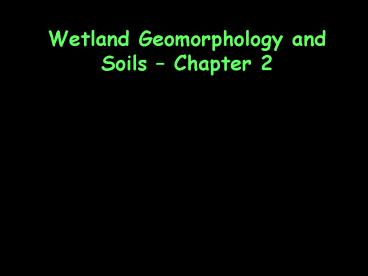Wetland Geomorphology and Soils Chapter 2 PowerPoint PPT Presentation
1 / 20
Title: Wetland Geomorphology and Soils Chapter 2
1
Wetland Geomorphology and Soils Chapter 2
2
Biogeochemistry
- interrelated physical, chemical, biological
processes - soil is where these interactions occur
3
Oxidizing Conditions
- losing electrons
- first used to describe oxygen combining
chemically with another substance - now includes other reactions
- oxidation of one compound involves reduction of
another
4
Reducing Conditions
- decrease in oxidation state
- gaining electrons
- more common before evolution of photosynthetic
organisms - now represented by a smaller part of Earths
surface namely wetlands
5
Earths Atmospheric Changes
- splitting of water molecules during
photosynthesis - amount of oxygen gas increased in the atmosphere
Biotic feedback
6
Hydric Soils
- form when oxygen is cut off
- reduced conditions dominate
- medium in which chemical transformations take
place
7
Organic Soils
- Page 13
- Organic Carbon content gt 12-18
- Saturated
- No clay 12 organic Carbon
- 60 clay 18 organic Carbon
- Not saturated
- Has 20 organic Carbon
8
Mineral Soils
- lt 20-35 OM
- if not organic, considered mineral
- does not mean that it cannot have an upper
organic peat layer (e.g., swamp forests may have
a 25 cm OM layer)
9
Mineral Soils
- lt 20-35 OM
- if not organic, considered mineral
- does not mean that it cannot have an upper
organic peat layer (e.g., swamp forests may have
a 25 cm OM layer)
10
Organic vs. Mineral Soils
- Organic soils
- higher porosity
- reduced bulk density (dry weight/known volume)
- higher hydraulic conductivity (ability to move
water) - lower nutrient availability because tied up in
organic form - higher cation exchange capacity
11
Cation Exchange Capacity Organic Soils
- sum of exchangeable cations (positive ions) is
higher - H, Ca 2, Mg 2, K, and Na
12
Cation Exchange CapacityMineral Soils
- can hold less cations
- mineral soils dominated by the major metal cations
13
Organic Content affects exchangeable ions
- with increased organic content, Hydrogen ions
increase in and amount - metal ions have a hump-shaped response
exchangeable ions
organic content
14
Composition and Origin of an Organic Soil
- mostly undecomposed remains of plants
- builds up because decomposition is slow under
anaerobic conditions - botanical origins
- mosses Sphagnum spp.
- herbaceous Panicum spp., Carex spp.
- woody material
- plant remains
- degree to which it is decomposed determines CEC,
porosity, conductivity
15
Classification of Organic Soils based upon
Decomposition
- Fibrists (peat) lt 1/3 decomposed
- Hemists (mostly peat) intermediate
- Saprists (muck) 2/3 decomposed
16
Mineral Soils
- when flooded, develop redoximorphic features
- refers to reduction/oxidation of iron and
manganese oxides - mediated by microbial activity
- conditions required
- anaerobic
- above 5 C
- have organic material as a substrate for microbes
17
Redox Depletions
- when soil is flooded for sufficient amount of
time, get grey to greenish blue colorations - due to reduction of iron to a soluble form Fe 2
(and Mn 2) - if leached from soil, leaves natural color of
parent material - reduced and then depleted from matrix
- development of darker color gleying
- may be at small scale
- or entire soil matrix may become gleyed
18
Redox Concentrations
- if not flooded, have a brownish, reddish color
- would tell you that drying occurs
- may have mottles surrounded by gleyed matrix
- dominance of iron oxides Fe 3
- manganese oxides black color Mn 3 or Mn 4
19
Oxidized Rhizosphere
- some hydrophytic species can pump oxygen down
their roots - will see evidence of iron oxides and manganese
oxides even after death of plant
20
Munsell Chart
- standardized color chart for comparing soil
color - used a lot to delineate wetlands
- hydric soils usually have a 2 or less in chroma
on the chart

